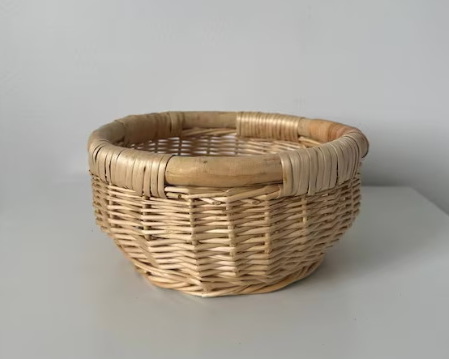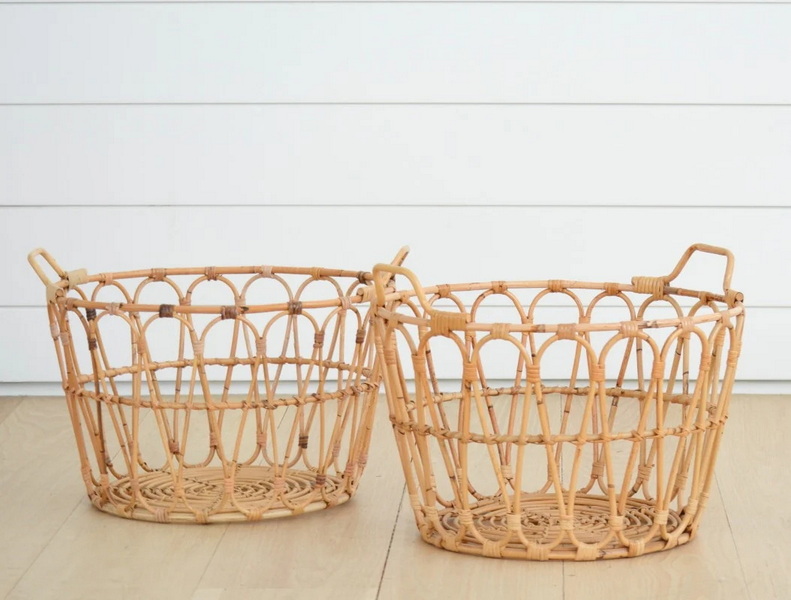Views: 222 Author: Tomorrow Publish Time: 2025-02-07 Origin: Site









Content Menu
● FAQ
>> 1. Why are wicker baskets so popular?
>> 2. How do I clean a wicker basket?
>> 3. Can wicker baskets be used outdoors?
>> 4. What are the different types of wicker weaving techniques?
>> 5. How can I repair a damaged wicker basket?
Wicker baskets, with their timeless charm and practical functionality, have been a staple in households for centuries. Among the diverse designs and shapes, the circular rim stands out as a prominent feature. But why does a wicker basket have a circular rim? This article explores the various reasons behind this design choice, delving into the structural, functional, aesthetic, and historical aspects that contribute to the prevalence of circular rims in wicker baskets.
![Round Wicker Basket] Round Wicker Basket]](http://ijrorwxhloqjlj5p.ldycdn.com/cloud/liBpkKlolkSRmkrmjplnjp/Round-Wicker-Basket.jpg)
The circular shape offers inherent structural advantages.
-Even Distribution of Stress: A circular rim distributes stress evenly across the entire structure of the basket. This is crucial for maintaining the basket's shape and preventing localized stress points that could lead to breakage or deformation. The absence of corners in a circular design means that no single point bears an excessive amount of weight or pressure[3].
-Resistance to Deformation: Compared to other shapes like squares or rectangles, a circle is more resistant to deformation under pressure. When a load is applied to the rim of a wicker basket has a circular rim, the circular shape allows the force to be distributed uniformly, minimizing the risk of bending or collapsing.
-Enhanced Stability: The continuous, unbroken nature of a circular rim enhances the overall stability of the basket. This is particularly important when the basket is used to carry heavy or bulky items. The circular rim provides a solid, consistent edge that helps maintain the basket's balance and prevents it from tipping over.
Beyond structural advantages, circular rims offer several functional benefits that enhance the usability of wicker baskets.
-Ease of Access: A circular opening provides easy access to the contents of the basket from any direction. This is particularly useful when the basket is used for storage or carrying items that need to be accessed frequently. The absence of corners means that users can reach into the basket without obstruction, making it more convenient to use.
-Efficient Space Utilization: The circular shape maximizes the use of space within the basket. Unlike square or rectangular baskets, which have corners that can be difficult to fill, a circular basket allows for more efficient packing and storage of items. This is especially beneficial when space is limited, and users need to make the most of the available volume.
-Smooth Edges: Circular rims typically have smooth, rounded edges that are gentle on the hands and prevent snagging or scratching. This is an important consideration for baskets that are used to carry delicate items or handled frequently. The smooth edges of a wicker basket has a circular rim ensure that users can interact with the basket comfortably and safely.
The aesthetic appeal of circular rims also plays a significant role in their popularity.
-Visual Harmony: The circular shape is often perceived as visually harmonious and pleasing to the eye. Its smooth, continuous lines create a sense of balance and symmetry that enhances the overall aesthetic of the basket. This visual appeal makes circular-rimmed wicker baskets attractive additions to any home decor.
-Timeless Design: Circular rims have been a consistent feature in wicker basket design throughout history. This timeless quality contributes to their enduring appeal and ensures that they remain relevant and stylish across different eras and design trends. The classic look of a wicker basket has a circular rim makes it a versatile piece that can complement a wide range of interior styles.
-Versatility: The circular shape lends itself well to various decorative treatments and embellishments. Whether adorned with woven patterns, braided accents, or other ornamental details, the circular rim provides a versatile canvas for showcasing craftsmanship and creativity. This versatility allows for a wide range of designs, from simple and understated to elaborate and ornate.
The historical context of wicker basket making sheds light on the origins and evolution of circular rims.
-Traditional Techniques: Many traditional wicker weaving techniques naturally lend themselves to circular forms. Coiling, twining, and plaiting, which are among the oldest and most common methods of basket making, often result in circular or rounded shapes[3]. The inherent properties of these techniques have contributed to the prevalence of circular rims in wicker baskets throughout history.
-Early Examples: Archaeological evidence suggests that circular baskets were among the earliest forms of woven containers. Fragments of circular baskets have been found in ancient sites around the world, indicating that this design has been in use for thousands of years. These early examples demonstrate the long-standing tradition of a wicker basket has a circular rim.
-Cultural Significance: In many cultures, wicker baskets with circular rims hold symbolic or ceremonial significance. They may be used in rituals, festivals, or other special occasions, representing concepts such as unity, continuity, or wholeness. This cultural significance further reinforces the importance and prevalence of circular rims in wicker basket design.
![Circular Rim On A Wicker Basket] Circular Rim On A Wicker Basket]](http://ijrorwxhloqjlj5p.ldycdn.com/cloud/ljBpkKlolkSRmkrmjpnnjp/Circular-Rim-On-A-Wicker-Basket.jpg)
Wicker baskets can be made from a variety of materials, each offering unique properties and aesthetic qualities[2]. The choice of material can also influence the shape and structure of the rim.
-Rattan/Cane: Rattan is a popular material for wicker baskets due to its strength, flexibility, and smooth texture[2][6][9]. Cane, which is the stem of the rattan plant, is often used to create sturdy rims that can withstand wear and tear.
-Willow: Willow is another commonly used material, known for its flexibility and shiny appearance[2][6]. Willow wicker is very strong and durable, so a quality willow basket will last for years to come[6].
-Bamboo: Bamboo is a lightweight and sustainable material that is often used for making wicker baskets[2]. While less flexible than rattan or willow, bamboo can be shaped into circular rims with careful craftsmanship.
-Hyacinth: Hyacinth is a strong and flexible fiber that is braided mostly as a whole stalk either as it is or after flattening it[2]. It's unique thick weave forms a decorative textured appearance[6].
The weaving techniques used to create wicker baskets also play a crucial role in shaping the rim[3].
-Plaiting: This technique involves overlapping strips of material in a basket weave pattern, commonly used for thin, flat materials like bamboo or willow[3]. Plaiting can create intricate patterns and designs, and it is often used for decorative baskets[3].
-Coiling: Coiling involves wrapping a long, pliable material around a center point and spiraling it outward to create a flat or rounded shape[3]. This technique is often used for larger baskets or bowls and can create a more organic, free-form design[3].
-Twining: Twining uses two or more flexible materials to weave around a central structure, twisting them together to create a spiral pattern[3]. This creates a tight, sturdy weave, often used for durable baskets[3].
In conclusion, the circular rim of a wicker basket has a circular rim due to a combination of structural, functional, aesthetic, and historical factors. The circular shape provides structural integrity by evenly distributing stress and resisting deformation. Functionally, it offers easy access, efficient space utilization, and smooth edges. Aesthetically, it is visually harmonious, timeless, and versatile. Historically, traditional weaving techniques and cultural significance have contributed to its prevalence. The materials used, such as rattan, willow, and bamboo, along with various weaving techniques like plaiting, coiling, and twining, further influence the design and durability of the circular rim. Understanding these aspects enhances our appreciation for the craftsmanship and enduring appeal of wicker baskets with circular rims.

Here are some frequently asked questions about wicker baskets with circular rims:
Wicker baskets are popular due to their durability, aesthetic appeal, and versatility. They can be used for storage, decoration, and various other purposes, making them a practical and stylish choice for many households.
To clean a wicker basket, use a soft brush or cloth to remove dust and debris. For tougher stains, you can use a mild soap and water solution. Ensure the basket is thoroughly dried after cleaning to prevent mold or mildew growth.
Some wicker baskets are suitable for outdoor use, especially those made from synthetic materials or treated with weather-resistant coatings. However, it's important to protect natural wicker baskets from prolonged exposure to moisture and sunlight to prevent damage.
Common wicker weaving techniques include plaiting, coiling, twining, randing, and over-under weave. Each technique produces a unique texture and pattern, contributing to the overall design and durability of the basket.
Repairing a damaged wicker basket depends on the extent of the damage. Minor repairs can be done with glue or replacement strands of wicker. For more significant damage, it may be best to consult a professional basket weaver.
[1] https://softmath.com/algebra-word-problems/show.php?id=6686
[2] https://asamaenterprise.com/blogs/wicker-baskets/different-types-of-material-for-wicker-baskets
[3] https://vatimahome.com/blogs/news/techniques-for-weaving-wicker-baskets-a-step-by-step-guide-to-the-weaving-techniques-used-in-making-wicker-baskets-including-plaiting-coiling-and-twining
[4] https://www.purpleculture.net/answer-key-for-new-practical-chinese-reader-3-workbook-article-11/
[5] https://grandillusions.co.uk/round-kubu-basket-twisted-rim
[6] https://wickerwise.com/blog/word-on-wicker-types-of-wicker-basket-materials/
[7] https://thanhcongcraft.com/how-to-make-a-wicker-basket/
[8] https://dqxy.zju.edu.cn/_upload/article/files/b6/a7/5a6d6d57405e8577bdac4c2f08c0/8275da60-a970-4ab5-91aa-bfa0ba9034d0.pdf
[9] https://www.interiorgifts.co.uk/ourshop/prod_7599435-Rattan-Wicker-Basket-Planter-Plant-Pot-Round-Woven-Rim-Natural.html
[10] https://wovenhill.co.uk/blogs/news/what-are-wicker-baskets-made-from